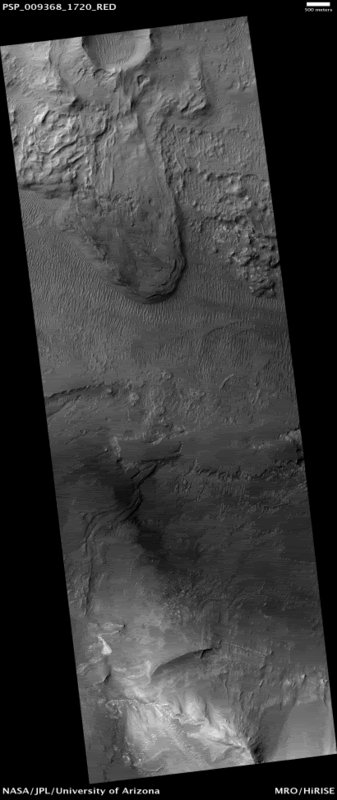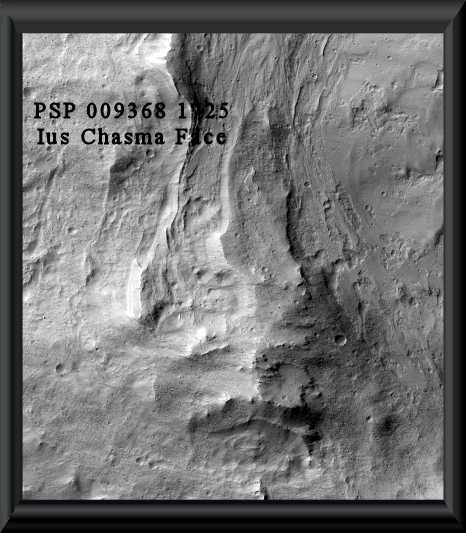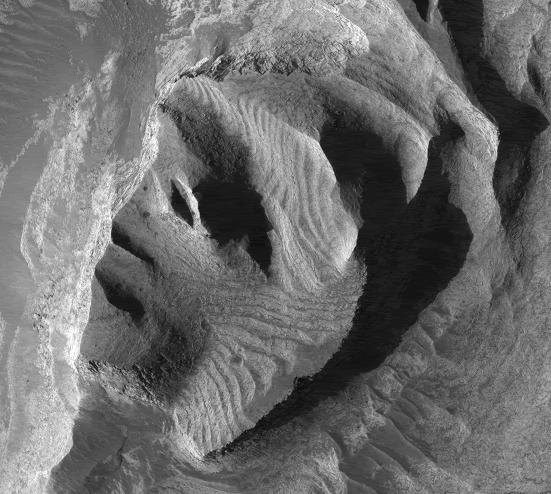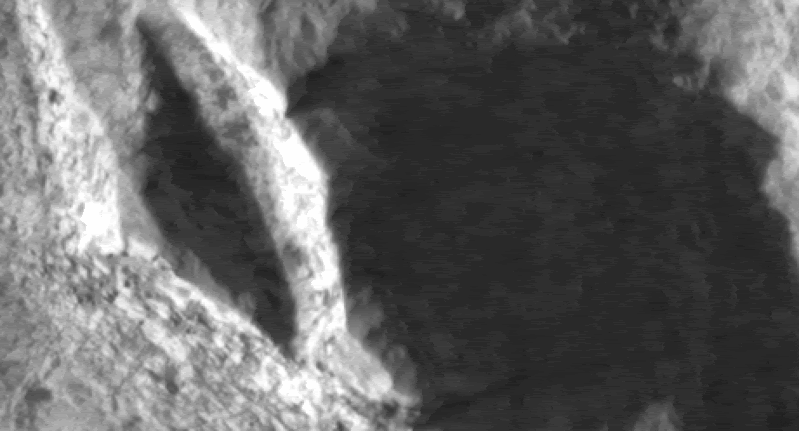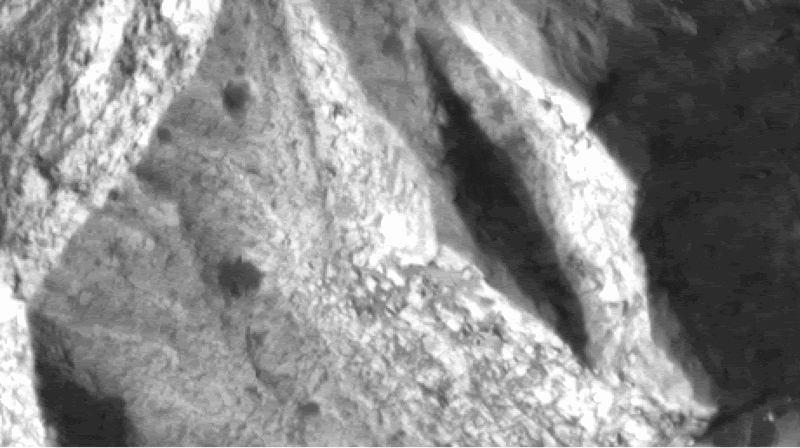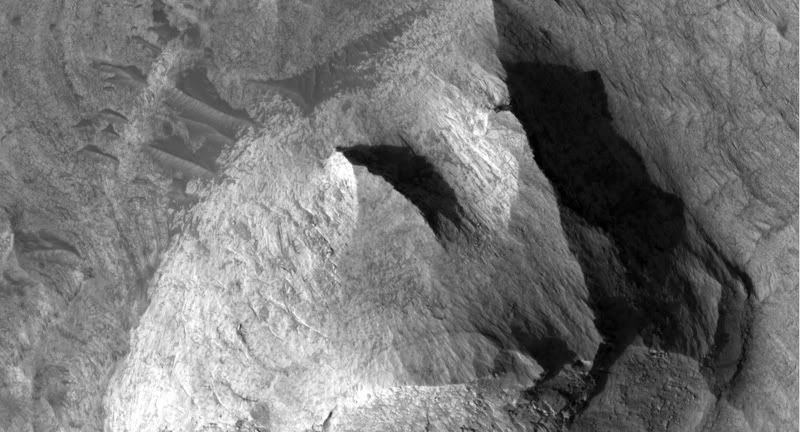- Thank you received: 0
Faces from the Chasmas
16 years 9 months ago #15404
by rderosa
Replied by rderosa on topic Reply from Richard DeRosa
<blockquote id="quote"><font size="2" face="Verdana, Arial, Helvetica" id="quote">quote:<hr height="1" noshade id="quote"><i>Originally posted by gorme</i>
<br /> So any genuine ruins would quickly find a place in the structure of science.<hr height="1" noshade id="quote"></blockquote id="quote"></font id="quote">That's an interesting point. But there appears to be somewhat of a double bind. What tools does an outsider have at his disposal to present the case that something is a "ruins" from an ancient civilization on Mars? All the cutting edge methods are in the hands of people who don't seem to be interested in persuing the idea that there are ruins at all.
rd
<br /> So any genuine ruins would quickly find a place in the structure of science.<hr height="1" noshade id="quote"></blockquote id="quote"></font id="quote">That's an interesting point. But there appears to be somewhat of a double bind. What tools does an outsider have at his disposal to present the case that something is a "ruins" from an ancient civilization on Mars? All the cutting edge methods are in the hands of people who don't seem to be interested in persuing the idea that there are ruins at all.
rd
Please Log in or Create an account to join the conversation.
16 years 9 months ago #20762
by gorme
Replied by gorme on topic Reply from Greg Orme
<blockquote id="quote"><font size="2" face="Verdana, Arial, Helvetica" id="quote">quote:<hr height="1" noshade id="quote"><i>Originally posted by rderosa</i>
<br /><blockquote id="quote"><font size="2" face="Verdana, Arial, Helvetica" id="quote">quote:<hr height="1" noshade id="quote"><i>Originally posted by gorme</i>
<br /> So any genuine ruins would quickly find a place in the structure of science.<hr height="1" noshade id="quote"></blockquote id="quote"></font id="quote">That's an interesting point. But there appears to be somewhat of a double bind. What tools does an outsider have at his disposal to present the case that something is a "ruins" from an ancient civilization on Mars? All the cutting edge methods are in the hands of people who don't seem to be interested in persuing the idea that there are ruins at all.
rd
<hr height="1" noshade id="quote"></blockquote id="quote"></font id="quote">
It's common in science for a new discovery to found or seed a new field. Exoarcheology exists in theoretical form as there are archeologists, atronomers, geologists, and SETI members. For example SPSR has all the disciplines for exoarcheology in its members. So once a discovery is made, if ever, then people from related disciplines would come together in conferences and eventually some would specialise in the new field. It would be very easy for archeologists to participate in current Martian conferences such as LPSC and those supported by the Mars society. Zubrin, the head of the Mars society believes alien civilisations should be close enough for us to see their rockets flaring as they decelerate into a star system, something brighter than many stars we can see now.
<br /><blockquote id="quote"><font size="2" face="Verdana, Arial, Helvetica" id="quote">quote:<hr height="1" noshade id="quote"><i>Originally posted by gorme</i>
<br /> So any genuine ruins would quickly find a place in the structure of science.<hr height="1" noshade id="quote"></blockquote id="quote"></font id="quote">That's an interesting point. But there appears to be somewhat of a double bind. What tools does an outsider have at his disposal to present the case that something is a "ruins" from an ancient civilization on Mars? All the cutting edge methods are in the hands of people who don't seem to be interested in persuing the idea that there are ruins at all.
rd
<hr height="1" noshade id="quote"></blockquote id="quote"></font id="quote">
It's common in science for a new discovery to found or seed a new field. Exoarcheology exists in theoretical form as there are archeologists, atronomers, geologists, and SETI members. For example SPSR has all the disciplines for exoarcheology in its members. So once a discovery is made, if ever, then people from related disciplines would come together in conferences and eventually some would specialise in the new field. It would be very easy for archeologists to participate in current Martian conferences such as LPSC and those supported by the Mars society. Zubrin, the head of the Mars society believes alien civilisations should be close enough for us to see their rockets flaring as they decelerate into a star system, something brighter than many stars we can see now.
Please Log in or Create an account to join the conversation.
- neilderosa
-
- Offline
- Platinum Member
-

Less
More
- Thank you received: 0
16 years 9 months ago #15408
by neilderosa
Replied by neilderosa on topic Reply from Neil DeRosa
<blockquote id="quote"><font size="2" face="Verdana, Arial, Helvetica" id="quote">quote:<hr height="1" noshade id="quote"><i>Originally posted by neilderosa</i>
<br /><blockquote id="quote"><font size="2" face="Verdana, Arial, Helvetica" id="quote">quote:<hr height="1" noshade id="quote"><i>Originally posted by marsrocks</i>
<br /><blockquote id="quote"><font size="2" face="Verdana, Arial, Helvetica" id="quote">quote:<hr height="1" noshade id="quote">"Water is a key condition for life as we know it. Though there is no firm evidence that Mars has ever harbored life, knowing that the planet was once wet suggests that it was at least habitable in the past.
The key to the finding is the discovery that rocks called phyllosilicates are widespread on at least the planet's southern hemisphere. The water present on Mars from about 4.6 billion to 3.8 billion years ago transformed some rocks into these phyllosilicates,..."<hr height="1" noshade id="quote"></blockquote id="quote"></font id="quote">
[url] www.space.com/scienceastronomy/080716-mars-water.html [/url]
<hr height="1" noshade id="quote"></blockquote id="quote"></font id="quote">
It is important to point out that the dates cited in the above post are derived from the conventional scheme of Mars' crustal evolution which basically derives from "crater counting" (as on the earth's Moon) The exploded planet hypothesis (EPH) postulates much more recent events as having caused the majority of the craters we now see on Mars. Many of the much older craters were probably covered by sediment and other geological evolutionary events as they were on earth. This means that the observed long-term presence of water noted in the quote could have been much more recently ended by the catastrophic EPH events. This allows for the possibility of life to have existed on Mars a mere few million years ago rather than billions, as in the conventional theory. [Neil]
(see "Why Mars has two unlike hemispheres" in the "Meta Science in the News" section of the current MRB metaresearch.org/publications/bulletin/2...es/0801/Mrb08ap6.asp )
<hr height="1" noshade id="quote"></blockquote id="quote"></font id="quote">
Here is a little exericise on the question of whether there are ways of determining the ages of artifacts.
Rather than the ~4 billion years ago Late Heavy Bombardment (LHB) of Mars of the conventional model, in the EPH model, Mars' southern dichotomy hemisphere was peppered (effectively covered) with fragments at ~65 million years ago (mya) and then again at 3.2 mya. If we accept this model, and if the two separate events can be differentiated with regards to their signature, (i.e., which craters or crater fields resulted from which EPH event), we should be able to look at a crater and say (approximately) how old it is or at least to place a limit on its age (say, no older than 65 myr). Now if we examine a particular crater and see gullies from past water runoff or erosion from wind, and if we see small craters within the larger crater, or other signs of erosion, such as landslides or rolling stone marks, (or artifacts), we can logically assume that these erosion marks were made after the crater had been formed. And if we look at a similar but pristine crater nearby, which has no signs of erosion, we can assume that this is a younger crater.
The model sets the parameters; evidence such as erosion gives clues as to the details which can fine tune the model, or even falsify it. Back on earth, Schoch knew that northern Africa was much wetter between 3 thousand years ago (kya) and 10 kya than it is today, so when he found runnels made from long exposure to rainfall, he felt he had found good evidence that the Sphinx was much older than in the conventional model.
One more thing. If within our hypothetical large crater we find small craters scattered approximately one per 10 meters square, but now we find also within the large crater a rectangle 500 m x 1 km, but with no small craters in it at all. We can assume that the rectangle is not only younger than the crater but also younger than most or all of the small craters.
<br /><blockquote id="quote"><font size="2" face="Verdana, Arial, Helvetica" id="quote">quote:<hr height="1" noshade id="quote"><i>Originally posted by marsrocks</i>
<br /><blockquote id="quote"><font size="2" face="Verdana, Arial, Helvetica" id="quote">quote:<hr height="1" noshade id="quote">"Water is a key condition for life as we know it. Though there is no firm evidence that Mars has ever harbored life, knowing that the planet was once wet suggests that it was at least habitable in the past.
The key to the finding is the discovery that rocks called phyllosilicates are widespread on at least the planet's southern hemisphere. The water present on Mars from about 4.6 billion to 3.8 billion years ago transformed some rocks into these phyllosilicates,..."<hr height="1" noshade id="quote"></blockquote id="quote"></font id="quote">
[url] www.space.com/scienceastronomy/080716-mars-water.html [/url]
<hr height="1" noshade id="quote"></blockquote id="quote"></font id="quote">
It is important to point out that the dates cited in the above post are derived from the conventional scheme of Mars' crustal evolution which basically derives from "crater counting" (as on the earth's Moon) The exploded planet hypothesis (EPH) postulates much more recent events as having caused the majority of the craters we now see on Mars. Many of the much older craters were probably covered by sediment and other geological evolutionary events as they were on earth. This means that the observed long-term presence of water noted in the quote could have been much more recently ended by the catastrophic EPH events. This allows for the possibility of life to have existed on Mars a mere few million years ago rather than billions, as in the conventional theory. [Neil]
(see "Why Mars has two unlike hemispheres" in the "Meta Science in the News" section of the current MRB metaresearch.org/publications/bulletin/2...es/0801/Mrb08ap6.asp )
<hr height="1" noshade id="quote"></blockquote id="quote"></font id="quote">
Here is a little exericise on the question of whether there are ways of determining the ages of artifacts.
Rather than the ~4 billion years ago Late Heavy Bombardment (LHB) of Mars of the conventional model, in the EPH model, Mars' southern dichotomy hemisphere was peppered (effectively covered) with fragments at ~65 million years ago (mya) and then again at 3.2 mya. If we accept this model, and if the two separate events can be differentiated with regards to their signature, (i.e., which craters or crater fields resulted from which EPH event), we should be able to look at a crater and say (approximately) how old it is or at least to place a limit on its age (say, no older than 65 myr). Now if we examine a particular crater and see gullies from past water runoff or erosion from wind, and if we see small craters within the larger crater, or other signs of erosion, such as landslides or rolling stone marks, (or artifacts), we can logically assume that these erosion marks were made after the crater had been formed. And if we look at a similar but pristine crater nearby, which has no signs of erosion, we can assume that this is a younger crater.
The model sets the parameters; evidence such as erosion gives clues as to the details which can fine tune the model, or even falsify it. Back on earth, Schoch knew that northern Africa was much wetter between 3 thousand years ago (kya) and 10 kya than it is today, so when he found runnels made from long exposure to rainfall, he felt he had found good evidence that the Sphinx was much older than in the conventional model.
One more thing. If within our hypothetical large crater we find small craters scattered approximately one per 10 meters square, but now we find also within the large crater a rectangle 500 m x 1 km, but with no small craters in it at all. We can assume that the rectangle is not only younger than the crater but also younger than most or all of the small craters.
Please Log in or Create an account to join the conversation.
16 years 9 months ago #15412
by gorme
Replied by gorme on topic Reply from Greg Orme
<blockquote id="quote"><font size="2" face="Verdana, Arial, Helvetica" id="quote">quote:<hr height="1" noshade id="quote"><i>Originally posted by neilderosa</i>
<br /><blockquote id="quote"><font size="2" face="Verdana, Arial, Helvetica" id="quote">quote:<hr height="1" noshade id="quote"><i>Originally posted by neilderosa</i>
<br /><blockquote id="quote"><font size="2" face="Verdana, Arial, Helvetica" id="quote">quote:<hr height="1" noshade id="quote"><i>Originally posted by marsrocks</i>
<br /><blockquote id="quote"><font size="2" face="Verdana, Arial, Helvetica" id="quote">quote:<hr height="1" noshade id="quote">"Water is a key condition for life as we know it. Though there is no firm evidence that Mars has ever harbored life, knowing that the planet was once wet suggests that it was at least habitable in the past.
The key to the finding is the discovery that rocks called phyllosilicates are widespread on at least the planet's southern hemisphere. The water present on Mars from about 4.6 billion to 3.8 billion years ago transformed some rocks into these phyllosilicates,..."<hr height="1" noshade id="quote"></blockquote id="quote"></font id="quote">
[url] www.space.com/scienceastronomy/080716-mars-water.html [/url]
<hr height="1" noshade id="quote"></blockquote id="quote"></font id="quote">
It is important to point out that the dates cited in the above post are derived from the conventional scheme of Mars' crustal evolution which basically derives from "crater counting" (as on the earth's Moon) The exploded planet hypothesis (EPH) postulates much more recent events as having caused the majority of the craters we now see on Mars. Many of the much older craters were probably covered by sediment and other geological evolutionary events as they were on earth. This means that the observed long-term presence of water noted in the quote could have been much more recently ended by the catastrophic EPH events. This allows for the possibility of life to have existed on Mars a mere few million years ago rather than billions, as in the conventional theory. [Neil]
(see "Why Mars has two unlike hemispheres" in the "Meta Science in the News" section of the current MRB metaresearch.org/publications/bulletin/2...es/0801/Mrb08ap6.asp )
<hr height="1" noshade id="quote"></blockquote id="quote"></font id="quote">
Here is a little exericise on the question of whether there are ways of determining the ages of artifacts.
Rather than the ~4 billion years ago Late Heavy Bombardment (LHB) of Mars of the conventional model, in the EPH model, Mars' southern dichotomy hemisphere was peppered (effectively covered) with fragments at ~65 million years ago (mya) and then again at 3.2 mya. If we accept this model, and if the two separate events can be differentiated with regards to their signature, (i.e., which craters or crater fields resulted from which EPH event), we should be able to look at a crater and say (approximately) how old it is or at least to place a limit on its age (say, no older than 65 myr). Now if we examine a particular crater and see gullies from past water runoff or erosion from wind, and if we see small craters within the larger crater, or other signs of erosion, such as landslides or rolling stone marks, (or artifacts), we can logically assume that these erosion marks were made after the crater had been formed. And if we look at a similar but pristine crater nearby, which has no signs of erosion, we can assume that this is a younger crater.
The model sets the parameters; evidence such as erosion gives clues as to the details which can fine tune the model, or even falsify it. Back on earth, Schoch knew that northern Africa was much wetter between 3 thousand years ago (kya) and 10 kya than it is today, so when he found runnels made from long exposure to rainfall, he felt he had found good evidence that the Sphinx was much older than in the conventional model.
One more thing. If within our hypothetical large crater we find small craters scattered approximately one per 10 meters square, but now we find also within the large crater a rectangle 500 m x 1 km, but with no small craters in it at all. We can assume that the rectangle is not only younger than the crater but also younger than most or all of the small craters.
<hr height="1" noshade id="quote"></blockquote id="quote"></font id="quote">
There is another aspect to this hard to explain by coincidence. Years ago Tom suggested that the Cydonia face was on an old Martian equator and new anomalies have turned up either on that equator or at symmetrical angles to it:
www.ultor.org/inline/1.htm
It is highly unlikely random formations would be selected on the basis of their appearence and then have a relation to a former pole position. Not only that, arguably some of these formations are related to two other previous pole positions, one at Meridiani and another near Tharsis. So they may have been either a message relating to previous pole positions or perhaps an ancient navigational system that changed as the pole moved, or perhaps it is all natural.
I developed an idea with a geologist friend that many volcanoes on Mars may have been created by hypothetical aliens with meteors to terraform the planet temporarily by heating it up:
www.harmakhis.org/terraforming.pdf
If so then these changing navigational marks might have been made as the poles moved after these impacts. In fact the idea of terraforming presented would work well for us today if we settle Mars.
<br /><blockquote id="quote"><font size="2" face="Verdana, Arial, Helvetica" id="quote">quote:<hr height="1" noshade id="quote"><i>Originally posted by neilderosa</i>
<br /><blockquote id="quote"><font size="2" face="Verdana, Arial, Helvetica" id="quote">quote:<hr height="1" noshade id="quote"><i>Originally posted by marsrocks</i>
<br /><blockquote id="quote"><font size="2" face="Verdana, Arial, Helvetica" id="quote">quote:<hr height="1" noshade id="quote">"Water is a key condition for life as we know it. Though there is no firm evidence that Mars has ever harbored life, knowing that the planet was once wet suggests that it was at least habitable in the past.
The key to the finding is the discovery that rocks called phyllosilicates are widespread on at least the planet's southern hemisphere. The water present on Mars from about 4.6 billion to 3.8 billion years ago transformed some rocks into these phyllosilicates,..."<hr height="1" noshade id="quote"></blockquote id="quote"></font id="quote">
[url] www.space.com/scienceastronomy/080716-mars-water.html [/url]
<hr height="1" noshade id="quote"></blockquote id="quote"></font id="quote">
It is important to point out that the dates cited in the above post are derived from the conventional scheme of Mars' crustal evolution which basically derives from "crater counting" (as on the earth's Moon) The exploded planet hypothesis (EPH) postulates much more recent events as having caused the majority of the craters we now see on Mars. Many of the much older craters were probably covered by sediment and other geological evolutionary events as they were on earth. This means that the observed long-term presence of water noted in the quote could have been much more recently ended by the catastrophic EPH events. This allows for the possibility of life to have existed on Mars a mere few million years ago rather than billions, as in the conventional theory. [Neil]
(see "Why Mars has two unlike hemispheres" in the "Meta Science in the News" section of the current MRB metaresearch.org/publications/bulletin/2...es/0801/Mrb08ap6.asp )
<hr height="1" noshade id="quote"></blockquote id="quote"></font id="quote">
Here is a little exericise on the question of whether there are ways of determining the ages of artifacts.
Rather than the ~4 billion years ago Late Heavy Bombardment (LHB) of Mars of the conventional model, in the EPH model, Mars' southern dichotomy hemisphere was peppered (effectively covered) with fragments at ~65 million years ago (mya) and then again at 3.2 mya. If we accept this model, and if the two separate events can be differentiated with regards to their signature, (i.e., which craters or crater fields resulted from which EPH event), we should be able to look at a crater and say (approximately) how old it is or at least to place a limit on its age (say, no older than 65 myr). Now if we examine a particular crater and see gullies from past water runoff or erosion from wind, and if we see small craters within the larger crater, or other signs of erosion, such as landslides or rolling stone marks, (or artifacts), we can logically assume that these erosion marks were made after the crater had been formed. And if we look at a similar but pristine crater nearby, which has no signs of erosion, we can assume that this is a younger crater.
The model sets the parameters; evidence such as erosion gives clues as to the details which can fine tune the model, or even falsify it. Back on earth, Schoch knew that northern Africa was much wetter between 3 thousand years ago (kya) and 10 kya than it is today, so when he found runnels made from long exposure to rainfall, he felt he had found good evidence that the Sphinx was much older than in the conventional model.
One more thing. If within our hypothetical large crater we find small craters scattered approximately one per 10 meters square, but now we find also within the large crater a rectangle 500 m x 1 km, but with no small craters in it at all. We can assume that the rectangle is not only younger than the crater but also younger than most or all of the small craters.
<hr height="1" noshade id="quote"></blockquote id="quote"></font id="quote">
There is another aspect to this hard to explain by coincidence. Years ago Tom suggested that the Cydonia face was on an old Martian equator and new anomalies have turned up either on that equator or at symmetrical angles to it:
www.ultor.org/inline/1.htm
It is highly unlikely random formations would be selected on the basis of their appearence and then have a relation to a former pole position. Not only that, arguably some of these formations are related to two other previous pole positions, one at Meridiani and another near Tharsis. So they may have been either a message relating to previous pole positions or perhaps an ancient navigational system that changed as the pole moved, or perhaps it is all natural.
I developed an idea with a geologist friend that many volcanoes on Mars may have been created by hypothetical aliens with meteors to terraform the planet temporarily by heating it up:
www.harmakhis.org/terraforming.pdf
If so then these changing navigational marks might have been made as the poles moved after these impacts. In fact the idea of terraforming presented would work well for us today if we settle Mars.
Please Log in or Create an account to join the conversation.
- neilderosa
-
- Offline
- Platinum Member
-

Less
More
- Thank you received: 0
16 years 9 months ago #20956
by neilderosa
Replied by neilderosa on topic Reply from Neil DeRosa
Here is what the HiRISE team has to say about the following image of Ius Chasma floor
hirise.lpl.arizona.edu/PSP_009368_1720
<blockquote id="quote"><font size="2" face="Verdana, Arial, Helvetica" id="quote">quote:<hr height="1" noshade id="quote">This image spans the floor of Ius Chasmas southern trench. Ius Chasma is located in the western region of Valles Marineris, the solar systems largest canyon. This canyon is well known for its fine stratigraphic layers modified by wind and water.
The outcrops contain interchanging layers of dark and bright rocks. The layered deposits consist of dark basalt lava flows and bright sedimentary layers. The sediments are likely to be from atmospheric dust, sand, or alluvium from an ancient water source. The layers are visible on the gentle slopes above the canyon floor, in pitted areas, and in small mesa buttes. The floor of the canyon is littered with megaripples that are aligned in a north-south direction.
Ius Chasma is believed to have been shaped by a process called sapping when water seeped from the layers of the cliffs and evaporated before it reached the canyon floor. This process is thought to have dominated during the Amazonian period.
Ius Chasma also has several structural features such as east trending normal faults and grabens that deformed the canyons. Recent geomorphological events include mass wasting (avalanches) and minor sapping from gullies that continued to erode the canyon walls.
<hr height="1" noshade id="quote"></blockquote id="quote"></font id="quote">
Aside from missing the face, which is expected, they missed the most glaring feature of the image: the 3 km wide crater at the base of the north slope and the mud/lava flow emanating from the crater into the chasma floor, which dominates the image. The face is just outside the left (west) rim of the crater, indicating that the crater is older because it would have decimated the face if pre-existing. [Neil]
Reduced browser image
Ius Chasma face. This face is about 400 m wide, comparable in size and detail to the famous crownface. It is also fairly eroded and pocked with small craters indicating perhaps relative age.
hirise.lpl.arizona.edu/PSP_009368_1720
<blockquote id="quote"><font size="2" face="Verdana, Arial, Helvetica" id="quote">quote:<hr height="1" noshade id="quote">This image spans the floor of Ius Chasmas southern trench. Ius Chasma is located in the western region of Valles Marineris, the solar systems largest canyon. This canyon is well known for its fine stratigraphic layers modified by wind and water.
The outcrops contain interchanging layers of dark and bright rocks. The layered deposits consist of dark basalt lava flows and bright sedimentary layers. The sediments are likely to be from atmospheric dust, sand, or alluvium from an ancient water source. The layers are visible on the gentle slopes above the canyon floor, in pitted areas, and in small mesa buttes. The floor of the canyon is littered with megaripples that are aligned in a north-south direction.
Ius Chasma is believed to have been shaped by a process called sapping when water seeped from the layers of the cliffs and evaporated before it reached the canyon floor. This process is thought to have dominated during the Amazonian period.
Ius Chasma also has several structural features such as east trending normal faults and grabens that deformed the canyons. Recent geomorphological events include mass wasting (avalanches) and minor sapping from gullies that continued to erode the canyon walls.
<hr height="1" noshade id="quote"></blockquote id="quote"></font id="quote">
Aside from missing the face, which is expected, they missed the most glaring feature of the image: the 3 km wide crater at the base of the north slope and the mud/lava flow emanating from the crater into the chasma floor, which dominates the image. The face is just outside the left (west) rim of the crater, indicating that the crater is older because it would have decimated the face if pre-existing. [Neil]
Reduced browser image
Ius Chasma face. This face is about 400 m wide, comparable in size and detail to the famous crownface. It is also fairly eroded and pocked with small craters indicating perhaps relative age.
Please Log in or Create an account to join the conversation.
- neilderosa
-
- Offline
- Platinum Member
-

Less
More
- Thank you received: 0
16 years 8 months ago #15448
by neilderosa
Replied by neilderosa on topic Reply from Neil DeRosa
If we assume that the hi-res MRO images are not tampered with, an assumption I think is reasonable, then here is some more evidence suggestive of artificiality. The images are contrast/brightness enhanced, which by previous consensus on this message board, is legitimate as it does not introduce new data; it merely enhances natural lighting effects.
The profile face "Wil," near Wil Faust's mound (both shown previously)
hirise.lpl.arizona.edu/PSP_002841_1740
hirise.lpl.arizona.edu/PSP_003896_1740
Close-ups of "eye": notice the jagged edge on right of "eye," probably intended by the artist to depict "lashes." Aside from the artistic aspect, the morphology (of the face as a whole and this detail) suggests artificiality as it is unlike anything in the surrounding terrain, subject to the same geological forces.
Natural outcroppings nearby for comparison
The profile face "Wil," near Wil Faust's mound (both shown previously)
hirise.lpl.arizona.edu/PSP_002841_1740
hirise.lpl.arizona.edu/PSP_003896_1740
Close-ups of "eye": notice the jagged edge on right of "eye," probably intended by the artist to depict "lashes." Aside from the artistic aspect, the morphology (of the face as a whole and this detail) suggests artificiality as it is unlike anything in the surrounding terrain, subject to the same geological forces.
Natural outcroppings nearby for comparison
Please Log in or Create an account to join the conversation.
Time to create page: 0.325 seconds

